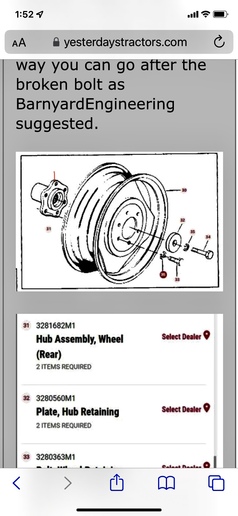Hello, new to this forum and hoping someone can help. I believe there have been a few (older) posts here related to the 1980-ish series of Massey Ferguson s MF 205 (the Japanese twin diesel compact tractor). I recently purchased one in reasonable shape, runs good, loader, back blade, etc. it will be very useful if I don t break anything else. Today I was out in the yard wrestling with stubborn rear wheel bolts and of course I broke one. I had soaked the hubs / bolts repeatedly over last couple days with penetrating oil. Some surrendered but this one gave me the finger and sheared off at the face of the hub. I don t have torches etc so I m thinking maybe I can yank this hub off and run it to a shop where they can clean it up for me. I would also like to inspect the axle /hub connection as there may be a bit of play there in the wheel.
Based on the original manuals (which are surprisingly not that great) maybe I can remove the hub retaining bolt / plate and pull them off. Right. Except maybe for 40 years of rusted crud that says otherwise?
If there are any MF 205 owners reading this, please let me know if rear wheel hub removal on these machines can be done by a mere mortal working out in the driveway in the knuckle-busting November cold? And if there are tips or tricks etc. to help? Thanks in advance.
This post was edited by rtoni on 11/06/2022 at 07:36 pm.
Based on the original manuals (which are surprisingly not that great) maybe I can remove the hub retaining bolt / plate and pull them off. Right. Except maybe for 40 years of rusted crud that says otherwise?
If there are any MF 205 owners reading this, please let me know if rear wheel hub removal on these machines can be done by a mere mortal working out in the driveway in the knuckle-busting November cold? And if there are tips or tricks etc. to help? Thanks in advance.
This post was edited by rtoni on 11/06/2022 at 07:36 pm.








